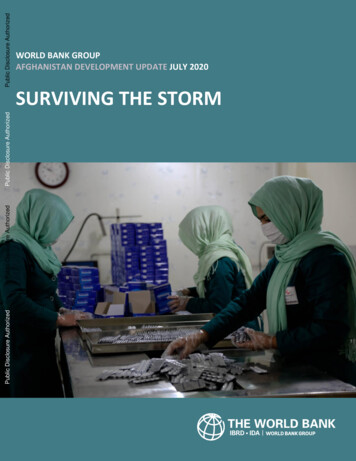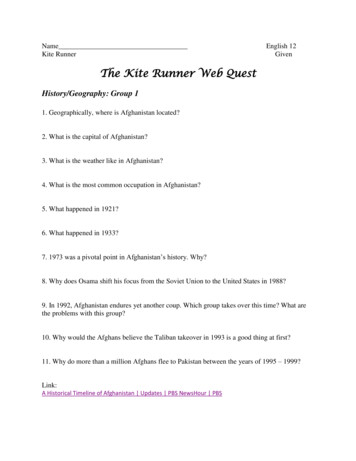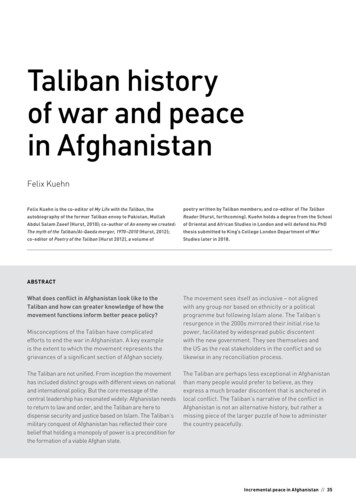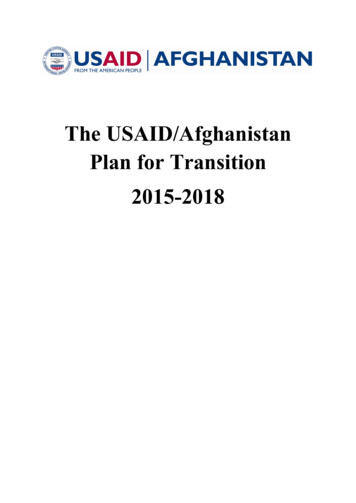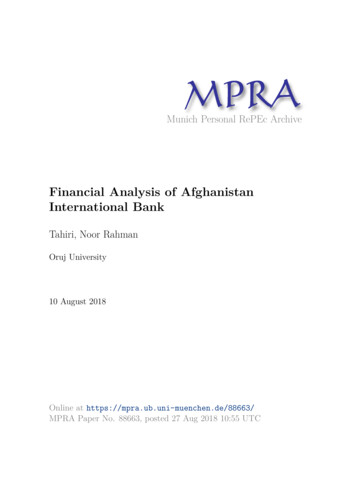
Transcription
Munich Personal RePEc ArchiveFinancial Analysis of AfghanistanInternational BankTahiri, Noor RahmanOruj University10 August 2018Online at https://mpra.ub.uni-muenchen.de/88663/MPRA Paper No. 88663, posted 27 Aug 2018 10:55 UTC
Financial Analysis of Afghanistan International BankNoor Rahman TahiriProfessor at Oruj UniversityKabul, Afghanistan 93789897554 - 93796266646tahiri.naved@gmail.com
Abstract:Afghanistan International Bank (AIB) is one the Afghanis commercial banks, its headoffice in Kabul. The bank has seven branch offices in the major cities of the country. AIB hasinternational shareholders, two Afghan business groups, and one Afghan/American businessgroup. It opened in 2004.Vision: We aspire to remain the most reputable financial institution and bank of choice inAfghanistan.Mission: Our mission is to foster economic development in Afghanistan, to be a catalystfor growth, and ultimately contribute to the prosperity of the country and its people.We strive to adhere to international best practices in corporate governance, financial and riskmanagement (including anti-money laundering and ‘know your customer’), customer service,operations, information technology, and internal controls. A major factor in our success isdedication to staff development and training within a culture of integrity and professionalism.Financial statements are made and organized by board of directors in order to report toshareholders in releasing of their stewardship function and also to corporate law directs theresponsibility of laying down prior to yearly shareholders general meeting, profit and lossaccount should be included in the balance sheet and auditor’s report should be attached theretoKeywords: Bank, Financial statement, analyzeJEL Classification Codes: G10, G21, G24
IntroductionAfghanistan is considered one of the poor countries in the globe, without any properinfrastructure in different dimensions, Banks are one of the most important factors which canbring vital changes in the living of people by issuing logical loans and offering different kinds offinancial opportunities for entrepreneurs, This research unveils the financial position of one ofthe most credible banks in Afghanistan (Afghanistan International Bank), meanwhile the firstchapter covers background of the study, statement of the problem, research questions, andjustification of the study, objective of the study, research methodology, and significance of thestudy, scope of the study, limitation and organization of the study.Company ProfileAfghanistan International Bank (AIB) is one the Afghanis commercial banks, its headoffice in Kabul. The bank has seven branch offices in the major cities of the country. AIB hasinternational shareholders, two Afghan business groups, and one Afghan/American businessgroup. It opened in 2004.AIB operates primarily as a commercial wholesale bank and targets, among others,multilateral organizations, UN entities, NGOs, embassies, foreign military forces, Afghangovernmental institutions, foreign and domestic companies, to become their clients.The bank operates from AIB House, which is located in Shahr-e-naw of Kabul City. Bank has itsbranchesin MazareSharif, Herat, Kandahar, Jalalabad, Kunduz PoleKhumri, Helmand, Nimruz,and Kabul City.
Afghanistan International Bank's assets are at approximately US 80 million. The WallStreet Journal has described the company as "one of the country's biggest lenders" (inAfghanistan).1.1.1 VisionWe aspire to remain the most reputable financial institution and bank of choice in Afghanistan.1.1.2 MissionOur mission is to foster economic development in Afghanistan, to be a catalyst forgrowth, and ultimately contribute to the prosperity of the country and its people.We strive to adhere to international best practices in corporate governance, financial andrisk management (including anti-money laundering and ‘know your customer’), customerservice, operations, information technology, and internal controls. A major factor in our successis dedication to staff development and training within a culture of integrity and professionalism.Problem StatementIn every entity particularly banking sector financial performance plays an essential role,defines competitiveness, opportunities of the business, and economic interests of the company’smanagement and reliability of current and future contractors. Therefore, financial performanceanalysis and identification of their weakness and strength using financial performance pointershas its own contribution to the shareholders, the regulator (the government), management, thepublic (customers of the bank), the financial sector, and the entire economy.The main purpose of financial statement is to provide information about the financial position,performance and changes and changes which occurs in financial status of an enterprise that isuseful for subscribers’ economic decisions.
Although very little research have been conducted on financial performance analysis of banks,such as insurance, performance comparison between the government and private banks, andother financial institutions, this kind of analysis in the case of Afghanistan international bank(AIB) I believe is still not unveiled.The most important point about this research is to analyze the financial position of AfghanistanInternational Bank.Research QuestionsThe research contains the following questions:1- What is the position of various elements financial trend in the financial statementslook like?2- Is the bank in a good position in term of liquidity?3- Can the bank survive in the market with its current financial position?Research Objectives1.1.1 General ObjectiveGeneral objective of the research is to analyze financial performance of AIB bank from differentaspects.1.4.2 Specific Objective To study and analyze various elements financial trend in the financial statements of AIB. To analyze risk and solvency position of AIB during four years. To analyze liquidity of AIB during multiple years.Significance of the StudyThis research will be effective and essential for different people, as this research rotates around avital issue of business scenario, the following can be the significances of this research.
1- It gives insight about the financial position of one of the important banks ofAfghanistan.2- To add vital knowledge for both academicians and practitioners.3- As AIB is one of the key banks in the territory, then its financial performance canreplicate the situation of banking in Afghanistan.Literature ReviewNeely et al., (1997), stated that “the financial system and banking issues and problemsturned to be critical and essential the quick past years over the globe. Both financial sector andbanking are really defenseless against the systemic crises which impacted to the eruption ofcostly safety nets, as a person who have deposit insurance schemes with well-known moralproblem. It has been told that there are several evidence that banks are “black boxes” due to theweek clearness or in other words transparency and banks not ready and not willing to unveil theinformation”.Kosmidou, K. (2008), argued that “Indicators of nonperforming loans and business beingfails are also usually available only at low rate, if at all; the latter are also made less informativeby banks desire to hide their problems for as long as possible.” This means that it is needed touse as fully and complexly as possible all available financial information from the officialfinancial statements of banks for making financial analysis of banks’ performance.Bernstein and Wild, (2000), mentioned that “Financial statements are made andorganized by board of directors in order to report to shareholders in releasing of theirstewardship function and also to corporate law directs the responsibility of laying down prior toyearly shareholders general meeting, profit and loss account should be included in the balancesheet and auditor’s report should be attached thereto”.
Khan, M Y, (2007), stated that “Analysis of financial statements reveals important factsconcerning managerial performance and the efficiency of the firm. Broadly speaking, theobjectives of the analysis are to apprehend the information contained in financial statements witha view to know the weaknesses and strengths of the firm and to make a forecast about the futureprospects of the firm thereby, enabling the analysts to take decisions regarding the operation of,and further investment in, the firm”.Jagels, et al., (2003), mentioned that “Financial analysis is the process of identifying thefinancial strengths and weaknesses of the firm by properly establishing relationships between thevarious items of the balance sheet and the profit and loss account. Financial analysis can beundertaken by management of the firm or by parties outside the firm, viz. owners, tradecreditors, lenders, investors, lab our unions, analysts and others”. The nature of analysis willdiffer depending on the purpose of the analyst.Fabozzi, et al., (2003), mentioned that “However, when a relationship is establishedbetween two numbers figuring in the three financial statements, i.e., balance sheet, incomestatement, and cash flow statement, one can make an assessment regarding the phenomenon.Ratio analysis involves calculation and interpretation of financial numbers by relating them in alogical manner in order to assess the strengths and weaknesses underlying the performance of anenterprise. We calculate ratios because in this way that we get a comparison that may prove moreuseful. In order to comment on the quality of a ratio one has to make a comparison with somestandard or benchmark”.Iqbal et al., (2005), stated that “Profitability ratios are generally considered to be thebasic bank financial ratio in order to evaluate how well bank is performing in terms of profit. For
the most part, if a profitability ratio is relatively higher as compared to the competitor(s),industry averages, guidelines, or previous years’ same ratios, then it is taken as indicator of betterperformance of the bank. In the banking literature, different scholars in measuring bankperformance have used many profitability ratios”.Samad and Hassan (2000), mentioned that “It measures the operating profitability of thebank with regards to its total operating expenses. Operating profit is defined as earnings beforetaxes and operating expenses means total non-interest expenses. The ratio measures the amountof operating profit earned for each dollar of operating expense. The ratio indicates to what extentbank is efficient in controlling its operating expenses. A higher PER means bank is cost efficientand is making higher profits”.Peters, Raad and Sinkey, (2004), argued that “Net interest income is the difference betweeninterest income and interest expense. It is the gross margin on a bank’s lending and investmentactivities. The higher the ratio the cheaper the funding or the higher the margin the bank isobtaining. A bank’s net interest margin is a key performance measure that drives ROA”.Samad and Hassan (2000), mentioned that “These ratios measure ability of the firm to meetits short-term obligations, maintain cash position, and collect receivables. In general, sense, thehigher liquidity ratios mean bank has larger margin of safety and ability to cover its short-termobligations. Because saving accounts and transaction deposits can be withdrawn at any time,there is high liquidity risk for both the banks and other depository institutions. Banks can get intoliquidity problem especially when withdrawals exceed new deposit significantly over a shortperiod of time”.
Data and Methodology3.1 Research Design:As the core focus of the study is on the description of data and awareness in the facts, theresearch design most sound and logical for the study was case study, quantitative and descriptiveResearch Design.3.2 Population:As this case study was on Afghanistan International Bank financial performance, so thenumbers for analysis was taken from the bank annual report which is being published annuallyon their official website. www.aib.af3.3 Sampling Size:In total four years financial report was extracted from the bank site.3.4 Sampling Technique:Among multiple years of financial report allocated on the bank website, I have takenlatest four of them for the study.3.5 Source of Data:I have taken the data from secondary sources, I have used observation and reviewingexisting data techniques for my research.3.5.1 Secondary Data Collection:Secondary data was collected from article, publications, various websites mostimportantly AIB website, text books, journals, newspapers, internets and other writings.
3.6 Data Analysis:I have chosen ratio analysis for being aware of Afghanistan international bank financialperformance, mainly liquidity ratio, solvency ratio and profitability ratio which are the mostimportant indicators of financial position.Findings and AnalysisRatio AnalysisAs it was already mentioned, a bank’s balance sheet and income statement are valuableinformation sources to evaluate financial strengths and weaknesses of a bank and its businesstrends. Although the birr amounts found on these statements provide valuable insights into thefinancial performance and condition of the bank, the researcher typically use data from them todevelop financial ratios to evaluate the bank financial performance. In all of the remainder of thischapter, the researcher undertakes key ratios commonly used by bank analysts to evaluatedifferent dimensions of financial performance of Afghanistan International Bank, includingliquidity, profitability, and credit risk & solvency in comparison with the industry average overfour years.4.1 Liquidity RatiosThe liquidity ratios measure the capability of bank to meet its short-term obligations.Generally, the higher value of this ratio indicates that firm has larger margin safety to cover itsshort-term obligations. Among the various liquidity measures, the study uses the following threeliquidity ratios.4.1.1 Loan to Deposit Ratio (LDR)Loan to deposit ratio indicates the percentage of the total deposit locked into non-liquidasset. A higher loan deposit ratio indicates that a bank takes more financial stress by making
excessive loan. Therefore, lower loan deposit ratio is always favorable to higher loan depositratio. This low value of loan deposit ratio also indicates effectiveness of mediation function ofbank.20139%LDR20145%20156%20167%Table 1LDR10%9%8%7%6%5%4%3%2%1%0%2013201420152016Graph 1InterpretationThe above chart obviously shows that AIB was in good position through out thesespecific four years in term of liquidity, although it was a bit higher in the beginning but turnedbetter in the two middle years, meanwhile as per our country political stability is concerned LDRmay increase, because the interest to invest in the country is degraded.4.1.2 Cash Deposit Ratio (CDR)
Another measure of liquidity of the bank is the cash to deposit ratio. The higher the ratiothe better is the liquidity position of the bank, therefore, the more is the confidence and trust ofthe depositors in the bank as compared to the bank with lower CDR.201357%CDR201443%201539%201632%Table 2CDR60%50%40%30%20%10%0%2013201420152016Graph 2InterpretationAs we can clearly see in the above plot is the drastic decrease in the bank CDR, which isobviously due to depositors trust on banks and also the general situation of this territory whichseems to be escalated toward ambiguous future, furthermore if the trend goes on the same paththen it would be really difficult for the bank to survive in the market.4.1.3 Loan to Asset Ratio (LAR)
The loans to assets ratio measure the total loans outstanding as a percentage of totalassets. The higher this ratio indicates a bank is loaned up and its liquidity is low. The higher the20139%LAR20145%20156%20166%ratio, the more risky a bank may be to higher defaults.Table 3LAR10%9%8%7%6%5%4%3%2%1%0%2013201420152016Graph 3InterpretationLAR of AIB is on decreasing trend over these four years, this decreasing trend of AIBLAR during these years indicates that AIB was doing well with its loans, and are efficient onmanaging their loans. Meanwhile AIB is taking by making excessive loans and holding lessliquid assets during the periods. However, this is an indication of potential betterment inprofitability and conforms to our results drawn from profitability ratios of AIB for the period.
4.2 Profitability RatiosProfitability is a management concept with the objective of assessment bank's resultsfrom efficiency point of view both for entirely activity and for differently managementcompounds. From conceptual point of view, profitability represents the modality to achieve themajor goal of bank's activity, respectively the maximization of profit in minimization riskconditions. In order to see how AIB has profitable in comparison with the industry average overseven years under the study, the study uses five profitability ratios namely, Return on assets(ROA), Return on Equity (ROE), Profit Expense Ratio (PER).4.2.1 Return on Assets (ROA)ROA is defined as the ratio of profit after tax to total asset. It reflects the efficiency withwhich banks deploy their assets. The higher the ROA, the most profitable is the bank.20134%ROA20143%20153%20163%Table 4ROA5%4%4%3%3%2%2%1%1%0%201320142015Graph 42016
InterpretationAs we can observe on the above chart is that ROA of AIB is quite stable in the analyzedfour years, meanwhile as per the percentage is concerned the profitability seems to be so low, thereason might be due to high expenses.4.2.2 Return on Equity (ROE)This ratio indicates how bank can generate profit with the money shareholders haveinvested. The higher value of this ratio shows higher financial performance. Like ROA, this ratiois also indicator for managerial efficiency.20139%ROE201416%201513%201613%Table 5ROE18%16%14%12%10%8%6%4%2%0%201320142015Graph 5Interpretation2016
The percentage in the above chart indicates that although ROE wasn’t that good in 2013but it had quite good improvement in the coming year, and decreased a bit in the consecutiveyears.4.2.3 Profit Expense Ratio (PER)This ratio indicates profitability of the firm with regard to its total expenses. A high valueof this ratio indicates that bank could make high profit with a given ble 6Graph 6InterpretationThe above graph indicates that AIB is doing well in term of PER comparing to the pastyears, and obviously the profitability is growing significantly better year on year, as per theinformation I have AIB is doing the best in the market comparing other banks in the market.
4.3 Risk and Solvency RatiosThe risk and solvency ratios measure the extent to which a firm relies on debt financingrather than equity financing. These ratios are also referred to as gearing, debt, or financialleverage ratios. These ratios determine the probability that the firm default on its debt contacts.The more the debt a firm has the higher is the chance that firm will become unable to fulfill itscontractual obligations. The following ratios measure for risk and solvency were used for thestudy.4.3.1 Debt to Equity Ratio (DER)This ratio indicates the proportion of assets financed with debt. A high value of this ratioprovides indication that firm involves in more risky ble 7Graph 7Interpretation
Debt to equity ratio of AIB decreased from 7,33% to 6.89% and eventually ended up to5.03% by end of 2016, the downward trend in DER of Afghanistan International bank shows thatdeposits base of the bank is decreasing more than its equity base.4.3.2 Debt to Total Assets Ratio (DTAR)DTAR measures ability of the bank capital to absorb financial shocks. This ratio indicatesthe proportion of assets financed with debt. A high value of this ratio provides indication thatfirm involves in more risky business.DTAR201356.02%201452.11%Table 8Graph 8201546.87%201639.09%
InterpretationAs we can clearly see in Table 8 and Graph 8 that DTAR is increasing year on yearwhich is not a good indicator of business for the bank, but still based on some information AIB isdoing much better than other banks exist in the industry.4.3.3 Equity Multiplier (EM)This ratio shows how many dollars of assets must be supported by each dollars of equitycapital. The higher value of this ratio indicates signal for risk e 50%0.00%2013201420152016Graph 9InterpretationThe analysis of equity multiplier further proves that AIB to be less risky and moresolvent, this result is consistent with our results found in DER and DTAR for Afghanistan
International Bank, no surprise, but EM is also exhibiting similar behavior as of DER. Whichfurther verifies that relative to debt, equity base is increasing more in AIB.Conclusion and Recommendation5.1 ConclusionAt this point, the financial analysis has been made in attempting to draw some roughconclusions on the performance of AIB. One of the main points to understand about the financialanalysis is that all the information that would be conclusive judgment about what is going on inthe company is found in the financial statements and interview with the concerned staff.From the brief explanation and illustrations of four years, financial statements of AIBhave been used to analyze the financial performance and their trend for the years under study(2013-2016).Examination of the empirical analysis makes it possible for the researcher to shed somelight on his findings and draw some conclusions. Some of the findings of the study include thefollowing: From the common size analysis of Income Statement, Operating income before Tax in2013 was lesser comparing to the other years. This was because of low Interest Expense, Salariesand benefits, and general and administrative expenses in this year. From the common size analysis of Balance Sheet, Total Loans, andAdvances of the bank had covered largest portion of total assets in all the years under thestudy, On the other hand, Total Deposit had covered largest portion of total liabilities in all theyears under the study. The researcher analysis of liquidity measures indicates that AIB is good in term ofliquidity in the market. Findings also show that this increasing trend is due to increase in its
deposits base, which can be considered a positive, and a good sign for the AIB in that it ismaking inroads into the society.Moreover, this shows that level of trust and confidence of the people is increasing in AIBwith the passage of time. Examination of all profitability measures, Return on assets (ROA), Return on Equity(ROE), Profit Expense Ratio (PER) and Return on Deposit (ROD) indicates that AIB isprofitable. Like in profitability, and risk & solvency measures, AIB is found to be efficient in termsof generating income or Income Expense Ratio (IER) and managing their expenses or OperatingEfficiency (OE). In contrast, AIB is more efficient in terms of utilization of their assets or AssetUtilization (AU) ratio. Although, Income Expense Ratio (IER), and Operating Efficiency (OE)suggest that AIB is significantly efficient but increasingly converging towards that of industryaverage, during 2013-2016. This gives us some insight regarding AIB’s improvement ingenerating income, utilization of assets, and effective management in controlling expenses.5.2. RecommendationsThe following recommendations, based on the above research findings, are forwardedbelow in order to enhance the financial performance of commercial banks:Analysis has shown that AIB indicates the tendency of comparatively more increase in depositsthan loans. This may indicate that AIB has conservative lending policy over the period under thestudy. This may be solved by revising the lending policy of the bank, such as maximizing theapproval limit of branches and districts, appointing trained managers and loan officers. Since2013, Loans and advances of AIB decreased because the Da Afghanistan Bank set a maximumoutstanding loan limit to all banks in the country to control inflation. If this continues, the bank
may become more liquid and be obliged to discourage deposit to decrease their interest expensesand this will adversely affect the overall economy.The regulatory body has to think over it and take a corrective action.Overall, all results of profitability measures results indicate that AIB is profitable in themarket, therefore the bank should work on keeping the momentum to move towards better returnbecause this is the means to assure its survival in the market.The number of commercial banks has been increasing from time to time. The intensive andcontinuous increasing competition in the financial service market creates a need foran access to information that would allow evaluating commercial banks operating in this market.In Afghanistan there is no adequately compiled data and bench marks to evaluate theperformance of commercial banks. The regulatory body ( Da Afghanistan Bank) or otherconcerned bodies have to take the responsibility.Finally, the financial performance indicators, i.e. financial ratios, independently are notenough to measure the performance of commercial banks. Thus, alternative financial measuressuch as Data Envelopment Analysis (DEA) shall be considered by further researchers.ReferencesAbdus, S. (2004),” Bahrain's Commercial Bank Performances during 1994 2001”:Retrieved fromhttp://findarticles.com/p/articles/mi qa3857/is 200401/ai n13454903Ahmad, A. U. F., & Hassan, M. K. (2007), “Regulation and Performance of IslamicBanking in Bangladesh”, Thunderbird International Business Review, 49(2), retrievedfromwww.ccsenet.org/journal.htmlBashir, (2001), “Determinants of Islamic banks’ performance across eight Middle
Eastern countries between 1993 and 1998”, September 2001.Retrieved , E.G., and James,W.K (2005), ”Commercial Banking”, 3rd Edition, Text, theManagement of risk, John wiley and sons.Bernstein, Leopold and Wild, John. (1998),” Financial Statement Analysis: Theory,Application and Interpretation”, New York: McGraw-Hill Companies, Inc.Bhushan B. (2008), “A Comprehensive Study on Financial Analysis: a case ofH.D.F.C.bank”Retrieved i, F.J and Peterson, p.p. (2003), “Financial Management and Analysis”, 2ndEdition. S.l. :john wiley and sons, Inc,Farooq, A.M. (2003), “Structure & performance of commercial Banks in Pakistan Munichpersonal from Omani Commercial Banks”: International Research Journal of Financeand Economics,ISSN Kurukshetra, April, 2008 Retrieved anni, Michele; Francesco Marchionne (2009). "Rescuing Banks from the Effectsof the Financial Crisis". SSRN Working Paper. Retrieved fromhttp://papers.ssrn.com/sol3/Delivery.cfm/SSRN ID1476786 code942286.pdf?abstractid 1476786&mirid 1.Girmachew, k. (2010),” Financial performance analysis”, A Case Study of MesfinIndustrial Engineering, Unpublished masters’ project. Mekelle University,EthiopiaGitman, L.J. (2004), “Principles of Managerial Finance”, 10th Edition. S.l. : PearsonEducation,Hasan, Z. (2005a), “Evaluation of Islamic banking performance: On the current useof econometric models”, Munich Personal RePEc Archive Paper No.6461,posted 27.Hempel, G. H., & Simonson, D.G. (1999),”Bank Management: Text and Cases”,Wiley and Sons, 5th Ed.Iqbal, M. and Molyneux, P. (2005), “Thirty Years of Islamic Banking: History,Performance and Prospects”, New York: Palgrave Macmillan.
Jagels, M.G. and Coltman, M.M. (2003), “Hospitality Management Accounting”, 8thEdition.s.l. : John wiley and sons.Kosmidou, K. (2008), “The determinants of banks‟ profit in Greece during theperiod of EU financial integaration”, Managerial Finance, 34 (3)My khan. P k Jain (2007), “Financial Management”, 5th Edition, Text, Problems andCases, Tata Mc Graw-Hill Publishing Company LimitedNeely, M.C. and Wheelock, D.C., 1997, "Why Does Bank Performance Vary AcrossStates?" , Federal Reserve Bank of St. Louis Review, Vol. 79, No. 2, MarchApril,Peters, D., Raad, E. and Sinkey F. Joseph (2004), “The performance of banks in postwar Lebanon”, International Journal of Business, 9(3), 259-28Ross, S. A., Westerfield, R. W, Jaffe, J. (2005), “Corporate Finance.” McGraw-HillInc., 7th Ed.Saleh, A. S. and Z. Rami (2006), “Islamic Banking Performance in the Middle East: ACase Study of Jordan.” Working Paper 06-21, Department of Economics,University of Wollongong.Samad, Abdus, and Kabir Hassan (2000), “The Performance of Malaysian IslamicBank During 1984-1997: An Exploratory Study.” Thoughts on Economics 10,no. 1 & 2:Sheikh Waqas, A. (2005), “Financial Statement Analysis of Bank Falah”; VirtualUniversity Pakistan, Pakistan; June 2005.
General objective of the research is to analyze financial performance of AIB bank from different aspects. 1.4.2 Specific Objective To study and analyze various elements financial trend in the financial statements of AIB. To analyze risk and solvency position of AIB during four years. To analyze liquidity of AIB during multiple years.
